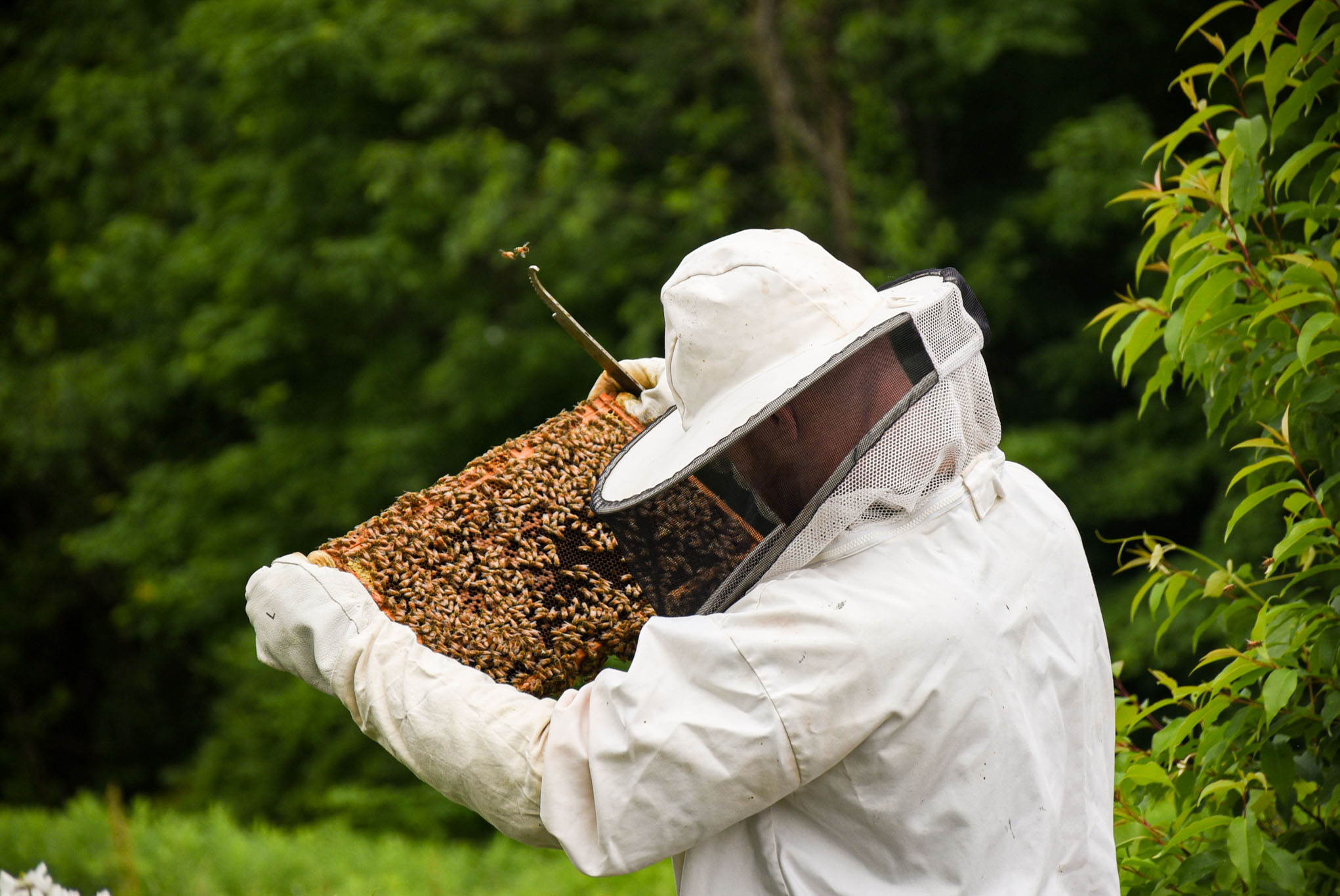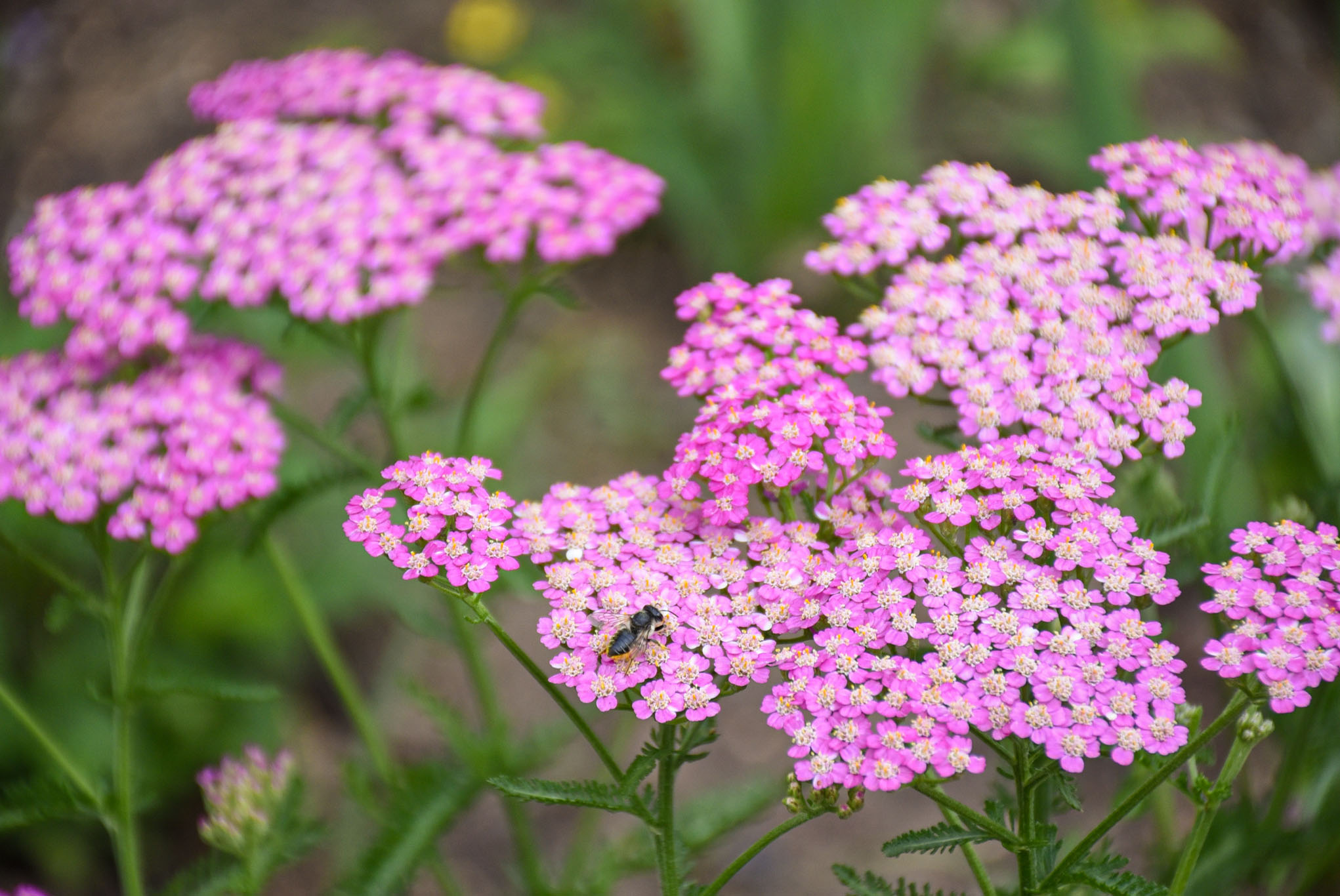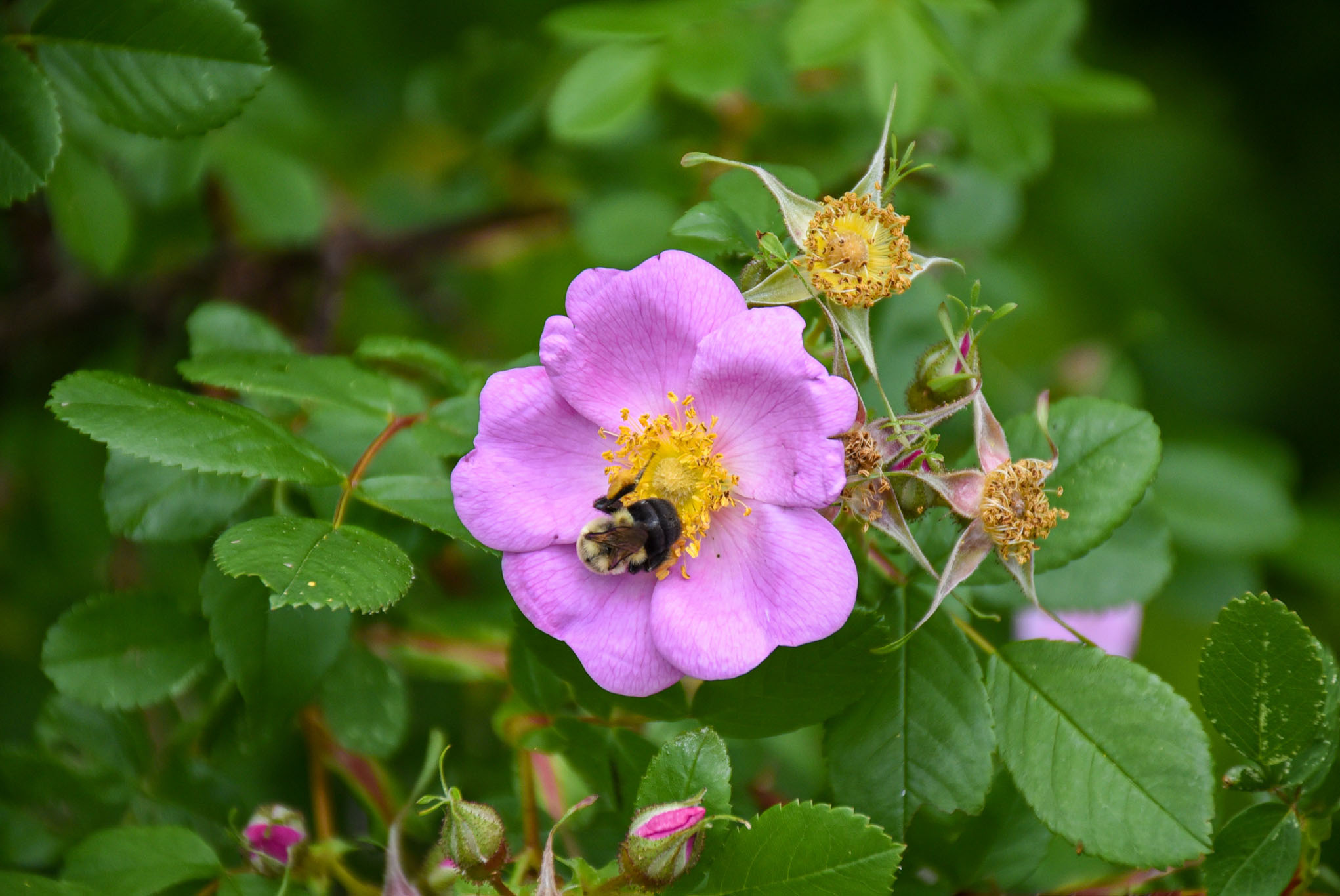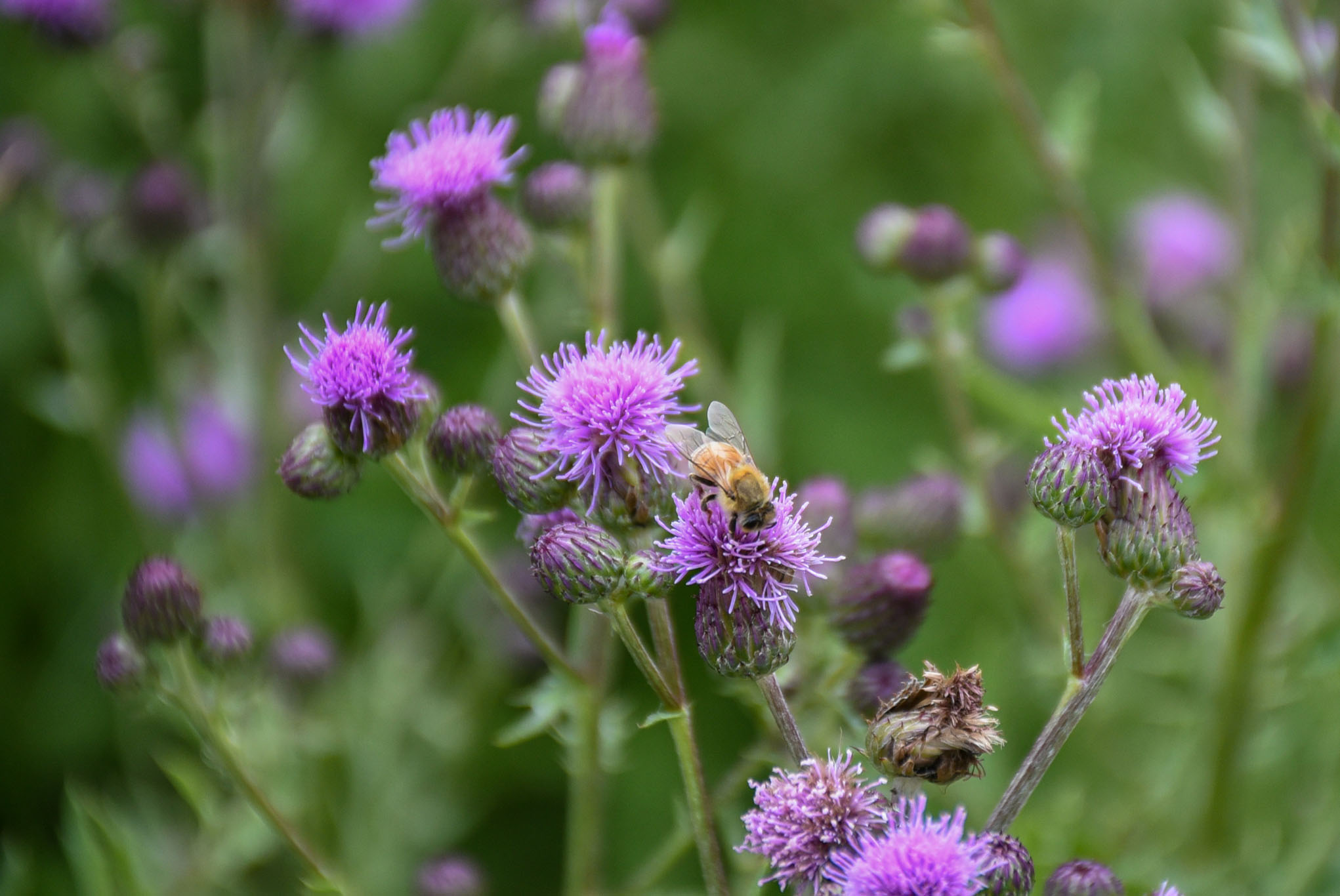“I’m seeing a lot of drone cells in this frame,” Hunter Blanchard says as he bends over the brood box.

Horticulturist and beekeeper Hunter Blanchard looks for queen cells in the hive.
Painted a creamy strawberry color, the Langstroth hive, stacked two boxes high, houses New England Botanic Garden’s resident Apis mellifera — western honey bees. The hives’ curious occupants emerge into the bright sunny day to buzz around Hunter as he examines the frames. He’s looking for signs of swarming.
Hunter is a horticulturist here at New England Botanic Garden at Tower Hill. He oversees the Garden’s many naturalistic spaces like the Inner Park, the Wildlife Refuge Pond, and the Shade Garden. He’s passionate about New England’s native plants and no newbie to the many insect species that pollinate them. At age thirteen, he learned beekeeping through Worcester County Beekeepers Association’s Bee School. From there, his love of bees only grew. Since 2020, he’s overseen the hive at the Garden.
Honey bees live in complex colonies. They organize their world according to a strict set of social roles. One queen rules the colony. Her strong pheromones guide the other bees and keep the colony intact. Thousands of female worker bees ensure the colony’s comfort and safety. They fly to and from the hive for miles to forage for pollen and nectar. Fewest in number are the drones, male bees whose main role is to fertilize the queen so she can lay new generations of bees.
The Garden doesn’t collect much honey from its hive, but careful maintenance is important all the same. The hive serves as a valuable educational tool. Among young guests especially, the honey bees offer an opportunity to learn about the ecological importance of pollinators and the essential role they play in the formation of the food we eat, the flowers we enjoy, and the habitats other animals rely on. In an age when pollinators across the globe are threatened by habitat loss, pesticide use, and climate change, there’s no better time to foster appreciation for the butterflies, birds, bats, and of course, bees in our own backyards.

A leaf cutter bee rests on some flowers in the Nadeau Garden.
Most plants—around 75 percent in North America—require pollination by insects. Honey bees receive a lot of public credit for this work, but they aren’t doing it all alone. Across the U.S., roughly 4,000 different bee species populate fields, forests, backyards, gardens, grasslands, and parks. These native bees, endemic to North America, come in a variety of colors and sizes. Their quest for food from flowers serves an essential ecological function.
So, why are honey bees so often the pollinator in the spotlight? Honey bees are excellent at what they do, Hunter says. And from their fuzzy thoraxes to their striped abdomens to their pollen-coated legs, honey bees possess an undeniable charisma. (Plus, they produce honey.) Something about a worker bee’s sense of duty to its sisters in the hive also pulls on our heartstrings. “They’re such beautiful creatures,” Hunter says. “They’ve got this job to do as soon as they’re born.”
At the Garden, part of the honey bees’ job includes being an ambassador. “If we can come to wonder at and care for the lives of honey bees,” Hunter says, “maybe we will care more for other important, lesser-known pollinators, like native bees, too.”
While bees face serious pressures in our modern world, there are things we can do to foster pollinator-friendly spaces. Here are some of the Garden’s favorites:
Plant Native Plants
Foraging for flowers comes easier to honey bees than some native bees. They are generalists and can feed on flowers of many different shapes and sizes. Some native bees specialize in collecting pollen from a single plant species alone. Millions of years of evolution tie the life cycles of these specialist bees to particular flowers. Planting species that are endemic, or naturally occurring, to your specific geography helps support native bees. (Read on for our New England recommendations!)

A bumblebee rolls around collecting pollen from a flower.
Choose Plants Grown from Seed
When selecting plants for your pollinator-friendly garden, choose species plants grown from seed instead of clonal cultivars. Research suggests that pollinators prefer native species over their cultivated counterparts. Some highly cultivated plants also lack the reproductive parts of the flower responsible for producing nectar and pollen. For example, Hydrangea arborescens ‘Annabelle,’ is the most common cultivar of this native hydrangea species, but unlike the naturally occurring species, the flowers on this plant are sterile, meaning no pollen, no nectar. “For pollinators, when we use plants that have been intensively bred, they can be like beautiful, sweet smelling food courts with all the lights turned on but no food inside,” Hunter says.
Extend the Bloom Period
During summer in New England, bees generally have access to lots of nectar. But external forces, like a long stretch of rainy weather, can limit a bee’s ability to forage. Even in high summer, resources may not always be plentiful within a bee’s flight range. When it comes to choosing plants for your home garden, consider when each blooms and try to offer up flowers that extend foraging resources over spring, summer, and fall. You’ll benefit from a consistently flowering garden, and your local bees will thank you.
To extend the bloom period with native plants, we recommend:
- Spring — Foamflower (Tiarella cordifolia), dutchman’s breeches (Dicentra cucullaria), and bloodroots (Sanguinaria canadensis) are great for native bees.
- Summer — Common milkweed (Asclepias syriaca) , purple coneflowers (Echinacea purpurea), and perennial sunflowers like Helianthus giganteus are favorites of native bees and butterflies.
- Fall — New England asters (Symphiotrichum novae-angliae) are terrific late fall bloomers for queen bumblebees foraging for the last drops of nectar for the season.
Provide Habitat for Bee Homes
Many native bees live solitary lives and build individual nests to raise their young. Miner bees burrow into the ground. Mason bees use mud. Leaf cutting bees use hollow stems and wood crevices lined with rolled up leaves. Cultivating a bit of untidiness in and around your yard or garden is one of the best things you can do to create a habitat for these bees. Leave some downed branches and fallen foliage. If you do crave a little uniformity, cut plants back by half, so stalks may serve as potential bee homes.
If you don’t have control over the landscaping where you live, or if you do and want to provide even more space for bees, consider building your own “bee condo” for solitary bees. Pollinator Partnership offers instructions to guide you.
Advance Conservation Through Community Science
The Beecology Project, a community science driven research project out of Worcester Polytechnic Institute, currently collects data about bumblebee diversity (there are 50 different species!) and bumblebee-plant relationships in New England. Community members of all ages are invited to use an app to document bumblebee sightings and share them with Beecology researchers. By collecting ecological information from across the region, the Beecology Projects aims to expand knowledge of native pollinators and inform conservation strategies.

A group of honeybees gather pollen from some nearby flowers.
Come See Pollinators in Action
Summer at New England Botanic Garden is a terrific time to see pollinators out in force. The milkweed throughout the meadows and the rose mallow (Hibiscus moscheutos) by the pond beckon the bees. Dusted with pollen, they flit between the flowers. On your next visit, we hope you’ll take a little time to pause and let these plants and their pollinators draw you in, too. We’d love to hear about all the different bee species you see!
—Liz Nye, New England Botanic Garden, June 2022
